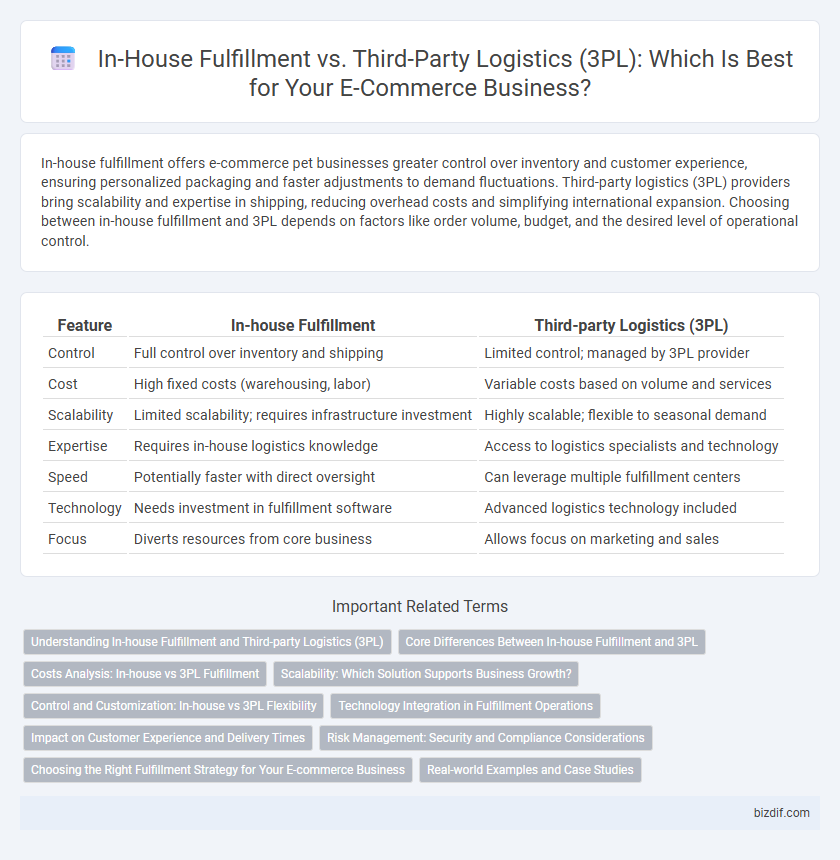In-house fulfillment offers e-commerce pet businesses greater control over inventory and customer experience, ensuring personalized packaging and faster adjustments to demand fluctuations. Third-party logistics (3PL) providers bring scalability and expertise in shipping, reducing overhead costs and simplifying international expansion. Choosing between in-house fulfillment and 3PL depends on factors like order volume, budget, and the desired level of operational control.
Table of Comparison
| Feature | In-house Fulfillment | Third-party Logistics (3PL) |
|---|---|---|
| Control | Full control over inventory and shipping | Limited control; managed by 3PL provider |
| Cost | High fixed costs (warehousing, labor) | Variable costs based on volume and services |
| Scalability | Limited scalability; requires infrastructure investment | Highly scalable; flexible to seasonal demand |
| Expertise | Requires in-house logistics knowledge | Access to logistics specialists and technology |
| Speed | Potentially faster with direct oversight | Can leverage multiple fulfillment centers |
| Technology | Needs investment in fulfillment software | Advanced logistics technology included |
| Focus | Diverts resources from core business | Allows focus on marketing and sales |
Understanding In-house Fulfillment and Third-party Logistics (3PL)
In-house fulfillment involves managing inventory storage, order processing, and shipping internally, providing full control over the supply chain and customer experience. Third-party logistics (3PL) providers offer outsourced services for warehousing, fulfillment, and distribution, enabling scalability and cost-efficiency for e-commerce businesses. Choosing between in-house fulfillment and 3PL depends on factors like order volume, operational expertise, and budget constraints.
Core Differences Between In-house Fulfillment and 3PL
In-house fulfillment involves managing inventory, packaging, and shipping internally, offering full control over the supply chain and customer experience, but requires significant investment in infrastructure and manpower. Third-party logistics (3PL) providers handle warehousing, order processing, and shipping, enabling scalability and cost efficiency while sacrificing some control over delivery timelines and service quality. The core differences lie in control, flexibility, cost structure, and resource allocation impacting operational efficiency and customer satisfaction in e-commerce businesses.
Costs Analysis: In-house vs 3PL Fulfillment
In-house fulfillment requires significant upfront investments in warehousing, labor, and technology, often leading to higher fixed costs but greater control over operations. Third-party logistics (3PL) providers offer scalable solutions with variable costs, reducing capital expenditure but introducing service fees and less direct oversight. Careful cost analysis should consider order volume, storage fees, labor expenses, and shipping rates to determine the most cost-effective fulfillment strategy for e-commerce businesses.
Scalability: Which Solution Supports Business Growth?
In-house fulfillment offers greater control and customization but may struggle to scale efficiently as order volumes increase, often requiring significant investment in infrastructure and labor. Third-party logistics (3PL) providers specialize in handling fluctuating demand, leveraging extensive networks and technology to support rapid business growth without substantial capital expenditure. Choosing 3PL enables e-commerce companies to scale operations seamlessly while focusing on core activities like marketing and product development.
Control and Customization: In-house vs 3PL Flexibility
In-house fulfillment offers e-commerce businesses direct control over inventory management, packaging, and shipping processes, enabling tailored customization to align with brand identity and customer experience. Third-party logistics (3PL) providers deliver scalable flexibility by leveraging advanced technology and extensive networks but may limit bespoke options due to standardized procedures. Choosing between in-house and 3PL fulfillment depends on prioritizing personalized service and brand control versus operational efficiency and broad distribution capabilities.
Technology Integration in Fulfillment Operations
Technology integration in fulfillment operations significantly enhances efficiency and accuracy, leveraging tools such as warehouse management systems (WMS), automated picking, and real-time inventory tracking. In-house fulfillment allows direct control over these technologies, enabling customized workflows and faster response times to operational issues, but requires substantial investment and technical expertise. Third-party logistics (3PL) providers often offer advanced, scalable technology platforms that seamlessly integrate with e-commerce systems, reducing the burden on retailers while optimizing order processing and shipping through sophisticated automation and data analytics.
Impact on Customer Experience and Delivery Times
In-house fulfillment offers e-commerce businesses greater control over inventory and packaging, often resulting in faster delivery times and a more personalized customer experience. Third-party logistics (3PL) providers leverage extensive networks and technology to scale operations, enhancing delivery speed and reliability but sometimes sacrificing direct oversight of order accuracy and packaging quality. Balancing in-house fulfillment and 3PL services depends on prioritizing customer expectations for speed, consistency, and customization in the delivery process.
Risk Management: Security and Compliance Considerations
In-house fulfillment offers direct control over inventory security and compliance with industry regulations, minimizing risks associated with data breaches and mishandling of products. Third-party logistics (3PL) providers implement specialized security protocols and adhere to standardized compliance frameworks, leveraging their expertise to mitigate risks related to supply chain disruptions and regulatory audits. Evaluating the robustness of security measures and compliance certifications is essential for effective risk management in either fulfillment strategy.
Choosing the Right Fulfillment Strategy for Your E-commerce Business
Selecting the right fulfillment strategy for your e-commerce business hinges on factors such as order volume, inventory control, and cost efficiency. In-house fulfillment offers greater control and customization for brands managing smaller volumes, while third-party logistics (3PL) providers excel in scalability, faster shipping, and reduced operational burdens for larger or rapidly growing businesses. Evaluating customer expectations, fulfillment speed demands, and long-term growth plans ensures optimal alignment between your e-commerce goals and fulfillment approach.
Real-world Examples and Case Studies
Amazon's success with in-house fulfillment demonstrates the advantages of direct control over inventory and shipping, enabling faster delivery times and improved customer satisfaction. Conversely, companies like Glossier leverage third-party logistics (3PL) partners such as ShipBob to scale rapidly while minimizing operational complexities and costs. Case studies reveal that businesses with fluctuating order volumes often benefit from 3PL services, whereas those needing tight control over brand experience prefer in-house fulfillment for customization and quality control.
In-house Fulfillment vs Third-party Logistics (3PL) Infographic

 bizdif.com
bizdif.com